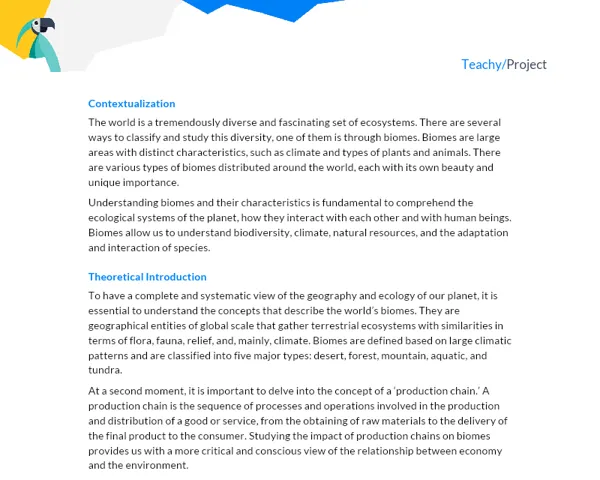Contextualization
Hello, class! In our project of the month, we are going to dive into a very important theme: Water Resources Management! But before we start, it is essential to understand the concepts behind it.
Let's begin with the water cycle, also known as the hydrological cycle. Here, we are talking about how water moves on the planet, between the atmosphere, the land, and the oceans. This process is vital for the maintenance of life as we know it. Water evaporates, forms clouds, falls as rain, flows in rivers to the oceans, and the cycle starts again.
Now, let's analyze surface runoff. It is the rainwater that flows over the surface of the terrain. This process is influenced by various factors, including the amount of rain, the type of soil, vegetation, the terrain slope, among others. In urban environments, impermeable surfaces accelerate this process, while in rural environments, vegetation helps to slow down runoff.
And finally, let's learn about watersheds, the areas where rainwater is collected and flows to a common point, usually a lake, a reservoir, or an ocean. The rivers and streams within a watershed are interconnected, and all contribute to the water flow.
Now, let's understand how this impacts our daily lives. Water is an essential resource for life on Earth. We use it for drinking, cooking, cleaning, irrigating our crops, and much more. However, it is easy to forget that water is not infinite. Although the water cycle naturally recycles water, excessive use and waste can lead to water scarcity.
That's why water reuse is so important. By reusing water, we are helping to preserve this precious resource. Water reuse can be done in various ways, such as collecting rainwater to water plants or reusing gray water (water that has been used in sinks, showers, washing machines) for toilet flushing.
But how can we, in practice, make good use of water resources? That's what we are going to discover in this project!
Research Sources
-
What is the water cycle or hydrological cycle? | Brazil School Understand in detail the water cycle and its importance for life on the planet.
-
Surface runoff | InfoSchool Understand the process of surface runoff and its influencing factors.
-
Watershed | InfoSchool Discover what a watershed is and how it works.
-
Water reuse: understand why it is important and how to do it | All Matter Learn about the importance of water reuse and how to do it.
Practical Activity
Activity Title: "H2O - Our Blue Treasure"
Project Objective
The objective of this project is to provide you, in groups of 3 to 5 people, the opportunity to explore the concepts of the water cycle, surface runoff, watersheds, and the importance of water reuse in a practical and playful way.
Project Description
During this project, you will create a model that represents a city or rural community and demonstrates how water moves in this environment. Additionally, you will design and implement a rainwater harvesting system for reuse. Our goal is to combine theory with practice and, at the end of the project, produce a detailed report on the learnings acquired.
Required Materials
To create the model:
- A large styrofoam or wooden board
- Adhesive tape
- Clay or modeling clay
- Plastic utensils, toothpicks, or barbecue skewers
- Acrylic paint of different colors and brush
- Transparent plastic (cellophane paper)
- Plants, rocks, gravel (or any other material that can represent the vegetation and geography of the location)
For the rainwater harvesting system:
- Small containers (plastic cups, for example)
- Drinking straws or thin plastic tubes
- Waterproof adhesive tape
- Large plastic bottle (for storing the collected water)
Project Step by Step
1. Firstly, as a group, research the concepts of the water cycle, surface runoff, watersheds, and water resources reuse. Use the provided sources and search for others that you find relevant.
2. Next, decide whether the model will represent a city or a rural community. Think about how the characteristics of the location influence water runoff and water resources utilization.
3. Start building the model. Use the materials to create mountains, rivers, buildings, houses, roads, etc. Remember to represent the characteristics of the water cycle, such as evaporation, precipitation, surface runoff, and watersheds.
4. Develop a rainwater harvesting system for the model. Think about how water could be collected and stored for future use. Test the system by simulating rain with a water sprayer.
5. Upon completing the model and the rainwater harvesting system, evaluate: does the model represent the studied concepts? Does the rainwater harvesting system work as expected? What changes could be made to improve it?
Project Delivery
After completing the project, each group should prepare a detailed report, which should include:
1. Introduction: Provide context to the theme, explain the relevance and application of water resources utilization in the real world, as well as the project's objective.
2. Development: Explain the theory behind the water cycle, surface runoff, watersheds, and water resources reuse. Describe the creation of the model and the rainwater harvesting system, detailing the steps taken, the methodology used, and the results obtained.
3. Conclusion: Conclude the work, summarizing its main points, explaining the learnings acquired, and drawing conclusions about the project.
4. Bibliography: Indicate the sources you relied on to work on the project, including books, web pages, videos, etc.
Remember: this is a group project. Therefore, it is expected that all members collaborate and contribute to the project's completion. Focus on teamwork, effective communication, problem-solving, creative thinking, and time management.
This project should take five to ten hours per participating student to complete and will have a one-month deadline. Good luck, everyone, and have fun learning!

